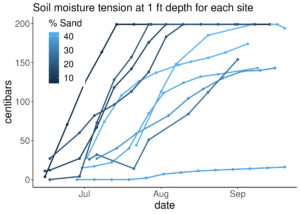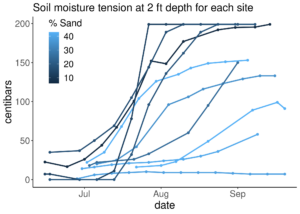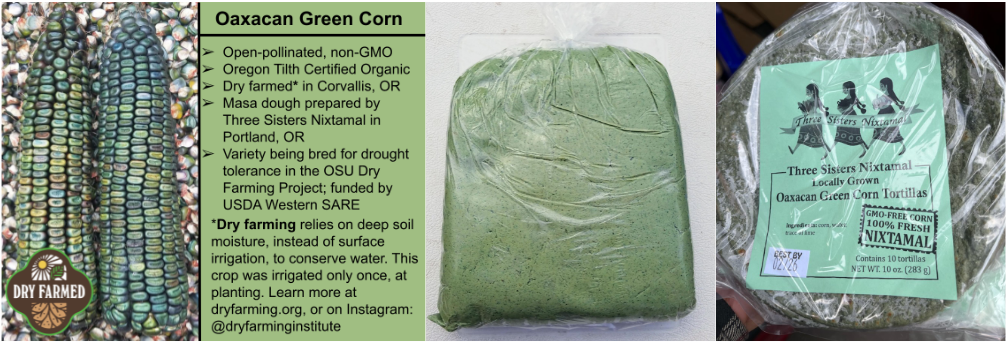Final report for OW21-366
Project Information
The Western United States is projected to be increasingly impacted by severe drought in the coming decades, so our agricultural production systems must adapt by limiting over-reliance on unsustainable irrigation practices. Dry farming is a method of producing crops without irrigation through the arid growing season, by accessing soil moisture retained from the wet season, through soil water conservation practices and using appropriate crop varieties.
The Oregon State University (OSU) Dry Farming Project (Corvallis, OR) and eleven participating producers across Oregon and Washington worked together to establish a participatory research network for sustainable corn production in the Pacific Northwest. Building upon drought tolerant corn research conducted by the OSU Dry Farming Project, this growing research network strives to provide the Pacific Northwest public with greater access to diverse corn varieties suitable for our region, and to help ensure that local production of this valuable staple crop is both environmentally and economically sustainable.
Our research team produced: (i) seed for an improved, drought-tolerant selection of Open Oak Party Mix dent corn (ii) breeding evaluations for Oaxacan Green dent corn and Dakota Black popcorn breeding lines, (iii) an analysis of dry farmed vs. irrigated corn production (iv) a preliminary assessment of how soil type and soil conservation methods affect dry farming success, and (v) established a research network for drought tolerant corn production that connects producers with consumers, culinary experts, breeders and seed stewards in the Pacific Northwest region.
Research Objectives
- Evaluate the dry farmed performance of three field corn varieties across multiple sites in Oregon and Washington
- Advance ongoing breeding efforts to improve the drought tolerance and culinary quality of select corn varieties
- Compare dry farmed versus irrigated corn production, including costs and benefits associated with water inputs, labor, and yield
- Test how no-till soil conservation methods impact dry farmed corn yield, soil water retention, and soil health measures
Educational Objectives
- Facilitate an educational exchange between agricultural professionals, producers, and farming-based organizations, focused on sustainable corn production in the PNW
- Connect corn producers with culinary experts and consumers to expand marketing potential of dry farmed corn
- Establish a formal participatory research network that can be built upon in future years
2021
April: Informational and Planning Meeting. Finalize research plans. Contact potential buyers of produce. Begin planning Pacific Northwest Corn Symposium event.
May-June: Experimental setup and planting. Soil samples. Documenting for Virtual Field Day.
July-August: Data collection of plant performance and soil moisture. Hand pollination of Open Oak Party Mix. Documenting for Virtual Field Day.
September: Virtual Field Day. Harvest Begins
October-November: Harvest and final data collection. End of the year soil sample collection. Send samples to culinary evaluators.
December '21 - January '22: Marketing and data analysis.
2022
February: Post-Season Winter Meeting
March: Pacific Northwest Corn Symposium meeting
Cooperators
- - Producer
- - Producer
- - Producer
- - Producer
- - Producer
- - Producer
- - Producer
- - Producer
- - Producer
- - Producer
Research
The overall aim of this project was to facilitate the dry farmed production of three drought tolerant culinary field corn varieties in the maritime Pacific Northwest region, by initiating a participatory research network that is centered on producers in Oregon and Washington. Doing so will help increase the resilience and adaptability of our region’s foodshed, and set a model for food system adaptation in the face of water scarcity and climate change. This project builds upon corn research conducted through the Oregon State University Dry Farming Project, led by OSU-based team members Lucas Nebert and Amy Garrett.
Research sites
There were seventeen research sites in this study, including four sites maintained by the OSU Dry Farming Project, eleven producer sites, ranging from southern Oregon to the northern Olympic Peninsula (Figure 1), and two additional volunteer sites. Eleven of these sites were provided with at least 3 Watermark moisture sensors (Irrometer, Riverside, CA) placed at 1 ft., 2 ft. and 3 ft depths, to determine the water availability to corn plants at different rooting depths over the course of the season. Ten sites had one representative soil sample taken at the beginning of the season to determine factors that may affect the success of dry farmed corn.
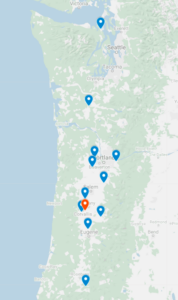
Corn varieties
Open Oak Party Mix corn (Adaptive Seeds, Brownsville, OR) is a genetically-diverse, open-pollinated population of New England flint and midwestern dent types, containing yellow, orange and red ears. It has been a top performer in past variety trials from the Dry Farming Project (2017, 2018), with dry farmed treatments yielding up to 89% of the yield of fully irrigated treatments. In 2019, we began to genetically improve the dry farming performance of this variety through the process of recurrent selection (Figure 3). We created 200 full-sib families through hand-pollination in 2019, and were able to evaluate these 200 breeding lines, irrigated and dry farmed, on two field sites in 2020. In addition to drought tolerance, we are selecting this variety for earliness for orange ears/kernels. For this project, we grew out the top breeding lines in 2021, allowing them to cross-pollinate, to produce seed for an improved population of this variety (Step 3 of Figure 3).
Oaxacan Green dent corn is locally popular, due to its striking palette of green-colored ears, and distinct flavor, and it is one of the few commercially available dent varieties that can adequately mature in the PNW climate. Three Sisters Nixtamal tortilleria in Portland is trying to source this variety locally as it produces distinctly flavored, green-colored tortillas. Contrary to its name, the ear and plant architecture resembles a modern midwestern dent corn, so there is controversy about its connection to Oaxaca. In 2020, we dry farmed the variety, and hand-pollinated it to produce 108 full-sib breeding families, which we evaluated in 2021, for dry farming performance, earliness, lodging resistance, and ear color.
Dakota Black popcorn originates from North Dakota, and is early-maturing in the Pacific Northwest. The rich flavored popcorn variety is being produced for wholesale markets and farm-direct in Oregon and Washington. In 2020, we dry farmed the variety, and produced 124 breeding families through hand pollination. We evaluated these breeding lines for dry farming performance, earliness, and popping quality.

Research Objectives
- Evaluate the dry farmed performance of three field corn varieties across multiple sites in Oregon and Washington
- Advance ongoing breeding efforts to improve the drought tolerance and culinary quality of select corn varieties
- Compare dry farmed versus irrigated corn production, including costs and benefits associated with water inputs, labor, and yield
- Test how no-till soil conservation methods impact dry farmed corn yield, soil water retention, and soil health measures
Research Materials and Methods
Research Objective 1: Evaluate the dry farmed performance of three field corn varieties across multiple sites in Oregon and Washington
Each project team member planted Open Oak Party Mix, Oaxacan Green, and/or Dakota Black popcorn for evaluation in seventeen diverse sites. Depending on the individual producers’ research and production goals, the team members grew one, two or all three of the varieties at their site (See Table 1, below). Team members not evaluating breeding material used bulk seed saved from the Dry Farming Project.
As the standard dry farmed treatment, all site operators grew varieties using basic organic dry farming practices, notably no irrigation following planting. Producer participants differed in the soil management practices used for dry farmed corn, including conventional tillage, no-till, and interplanting with beans; experimental plots were at least 100 sq. ft. in size. One site contained a till vs. no-till treatment, and three other sites compared dry farmed vs. irrigated yield. On all sites, corn was planted at a density of 2 sq. ft. per plant. Site operators measured stand count, pollination dates, and yield, as well as soil moisture weekly throughout the season, at 1', 2' and 3' depths.
Research Objective 2: Advance ongoing efforts to improve the drought tolerance and culinary quality of select corn varieties
Recurrent Selection Process
The breeding technique employed for this project is recurrent selection, using full-sibling families (Figure 3). The recurring selection cycles have three steps, which can be implemented over the course of two to three growing seasons: 1. Creation of new full-sib families, 2. Evaluation of full-sib families, and 3. Recombination through open-pollination (and concurrent creation of new sull-sib families). The product is an improved, open-pollinated (OP) variety. By evaluating the families, and then recombining only the top performing (~20%) of families using saved seed, the population can be improved relatively quickly, yet maintain its genetic diversity through time. This process works well for complex traits involving many genes, such as drought tolerance.
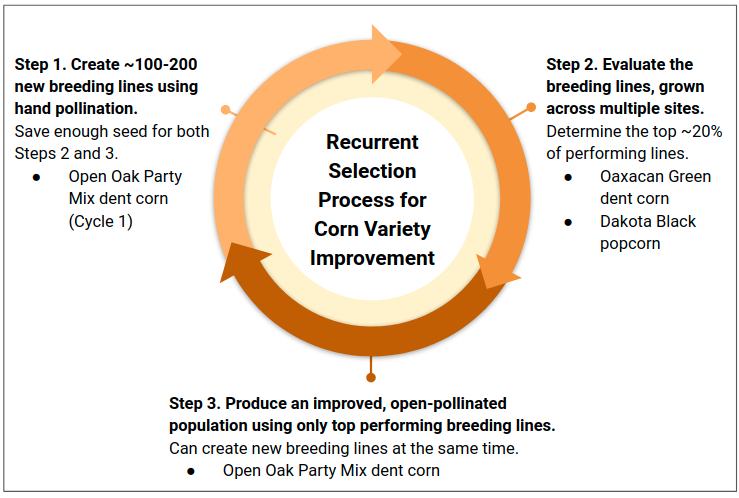
Recombination and generation of new full-sib families of Open Oak Party Mix
At one site, we grew out the top 40 full-sibling families by pooling them with a balanced amount of seeds on 1/10 of an acre. The improved, open-pollinated seed is one important output from this project. We also hand pollinated between individual plants in this improved population to create 200 new full-sibling families, to be used for further variety improvement.
Evaluation of Oaxacan Green and Dakota Black full-sib families
Oaxacan Green and Dakota Black full-sib families (120 each) were each evaluated under dry farmed conditions on two sites (Table 1). Each family was planted in 20 ft. strip plots, 20 seeds planted at 12 in. spacing. At each site per breeding family there were either two replicate plots (Dakota Black popcorn) or three replicate plots, Oaxacan Green dent corn, for a total of 4 and 6 replicates, respectively. Evaluation measures will included silking dates, anthesis-silking interval (days elapsed between pollen shed and silk emergence, an indicator of drought stress), lodging rate, and the yield and ear number per plot. Additionally, harvested ears were evaluated for color and quality. Kernels harvested from Dakota Black breeding lines will be further evaluated for popping performance.
Research Objective 3: Compare dry farmed versus irrigated corn production, including costs and benefits associated with water inputs, labor, and yield
Experimental design
Sites with an irrigation treatment had an irrigated plot at least 30 ft. away from the dry farmed plot to limit spray and microclimate effects of irrigation, and not more than 100 ft away from the dry farmed plot to limit spatial effects on yield differences between the plots. Producers used preferred irrigation methods (e.g., drip or overhead) and used provided moisture meters to optimize irrigation for their particular site needs. Site operators measured moisture levels on a weekly basis at 1 ft., 2 ft., and 3 ft. depths in both irrigated and dry farmed plots, and kept track of labor required under both soil management strategies.
Profitability analysis
Three team members quantified the costs and benefits of dry farming through dry farmed vs irrigated plots on select research sites, including water inputs, yield, and labor. In late April 2022, all eleven producers of the project attended with a Know Your Cost to Grow training, produced by Tanya Murray of Oregon Tilth, to help them quantify material and labor costs for their produce, to arrive at a price point for buyers.
Research Objective 4: Test how no-till soil conservation methods impact dry farmed corn yield, soil water retention, and soil health measures
Experimental design
Site operators at the OSU Oak Creek site compared a no-till dry farming treatment to the conventional tillage dry farming treatment in adjacent plots, of 1000 sq. ft. in size. Three participant sites used only no-till methods, and did not manage a conventional tillage site for comparison, due to lack of capacity and desire to till their soil. These managers used preferred no-till methods, including overwintered cover crops, mulching, or a combination of the two. Site operators measured moisture levels on a weekly basis at 1 ft., 2 ft., and 3 ft. depths in both conventional and no-till dry farmed plots. For each corn variety tested, we will measure stand count, pollination dates, plant height, yield, ear number and ear quality.
Table 1: Overview of seventeen sites involved in 2021 dry farmed corn breeding and variety trials. Non-OSU sites were the locations of the eleven producer participants, and two additional unpaid volunteers (Albany, OR, and Troutdale, OR).
| Site | Acres Committed | Has Dry Farmed Before (Y/N) | Trial Type | Management | Dakota Black | Oaxacan Green | Party Mix | Outcome |
| OSU, Lewis Brown | 1.00 | Y | Breeding | Conv. tillage | X | X | Harvest | |
| OSU, Oak Creek | 0.05 | Y | Variety Trial | No-till vs. Conv. | X | Harvest | ||
| OSU, VRF | 0.50 | Y | Breeding | Conv. tillage | X | Harvest | ||
| OSU, Peoria | 0.10 | Y | Seed Increase | Conv. tillage | X | Harvest | ||
| Albany, OR | 0.02 | Y | Variety Trial | Variety Trial | X | X | Harvest | |
| Chimacum, WA | 0.25 | N | Variety Trial | Conv. tillage | X | X | Crop failure | |
| Corbett, OR | 0.03 | Y | Variety Trial | No-Till | X | Harvest | ||
| Curtis, WA | 0.14 | N | Variety Trial | No-Till | X | Crop failure | ||
| Eugene, OR | 0.10 | N | Variety Trial | Conv. tillage | X | Harvest | ||
| Hillsboro, OR 1 | 0.07 | N | Variety Trial | No-Till | X | Harvest | ||
| Hillsboro, OR 2 | 1.00 | N | Variety Trial | No-Till | X | X | Crop failure | |
| Independece, OR | 0.03 | Y | Variety Trial | Irrigation vs. dry | X | Harvest | ||
| Myrtle Creek, OR | 0.50 | Y | Variety Trial | Irrigation vs. dry | X | Harvest | ||
| Philomath, OR | 0.50 | Y | Breeding | Conv. tillage | X | Harvest | ||
| Sweet Home, OR | 0.25 | N | Variety Trial | Irrigation vs. dry | X | Harvest | ||
| Troutdale, OR | 0.03 | Y | Variety Trial | Conv. tillage | X | Harvest | ||
| Woodburn, OR | 0.50 | N | Variety Trial | Strip tillage | X | X | X | Harvest, no data |
Analysis methods
This dataset included a broad variety trial across seventeen diversely managed research sites, as well as a more intensive, replicated breeding evaluation of Oaxacan Green and Dakota Black corn varieties.
Variety Trials
The variety trials dataset represented a single year of research involving diverse producers with different management strategies, farming histories, and corn variety choices. To allow for flexibility of different producers' needs and preferences, the study design was necessarily unbalanced and incomplete However, we are able to create a visual summary of dry farming success of multiple varieties across sites, and to use soil data such as moisture profile, texture, and nutrient profile as explanatory variables to determine the most significant predictors of dry farmed corn yield.
Breeding family evaluations
Across the three sites where we evaluated Oaxacan Green and Dakota Black breeding lines in dry farmed conditions, proper replication of breeding families in a randomized incomplete block design enabled for us to use more statistically-rigorous analysis methods to delineate the top-performing breeding lines. We used the following measures to quantify breeding line performance: days to silk emergence, anthesis-silking interval, lodging rate, yield per plot, ears per plant, ear quality score, and ear color. Anthesis-silking interval, or ASI, is the amount of days elapsed between pollen shed and silk emergence; a higher ASI indicates more drought stress. We normalized the average measure for each family by taking the z-score, or its number of standard deviations from the mean of all families together, in the positive or negative direction. We then created an additive equation to set a selection index for each family:
selection index = 1*(yield per plant )+ 1*(marketable yield) + 1* (ears per plant) + 2 * (ear score) - 1 * (days to silk emergence) - 1* (anthesis-silking interval) - 1 * (lodging rate) - 1* (off-colored ears)
We identified the top 20% of families with the greatest selection index for planting together as an improved, open-pollinated population in 2022.
Survey
Producers also completed a survey in December 2021, to provide feedback about the project design, how their perceptions of and capacity for dry farming corn may have changed due to the project, as well as their commitment to continue to participate in this emerging research network of dry farmed corn in the Pacific Northwest.
Dry farmed variety trial summary
As few producers grew multiple corn varieties on the same site, there were not many cases of within-site comparison between varieties (Table 1, Figure 4). Therefore, differences in performance between varieties are confounded by between-site differences in management and soil type. With this in mind, we see that Open Oak Party Mix performed the best in dry farmed conditions in terms of yield per acre, followed by Oaxacan Green, and Dakota Black popcorn (Table 2). Dakota Black popcorn matured the earliest in the maritime Pacific Northwest, and was harvested at 119 days on average, followed by Open Oak Party Mix harvested at 128 days, and finally Oaxacan Green dent corn harvested at 140 days.
These data represent the results of twelve of seventeen sites, as three sites experienced crop failures and one could not report yield data. In each of these cases of crop failure, the site operator had not dry farmed corn before, and were attempting to dry farm on a new site.
Table 2: Summary of dry farmed variety trial
| Variety | Yield per Acre, lbs (Standard Error) | Days to Harvest (Standard Error) |
| Dakota Black popcorn (6 sites) | 1625 (±455) | 119 (±3) |
| Oaxacan Green dent corn (6 sites) | 2172 (±729) | 140 (±6) |
| Open Oak Party Mix dent corn (2 sites) | 3732 (±1257) | 128 (±1) |
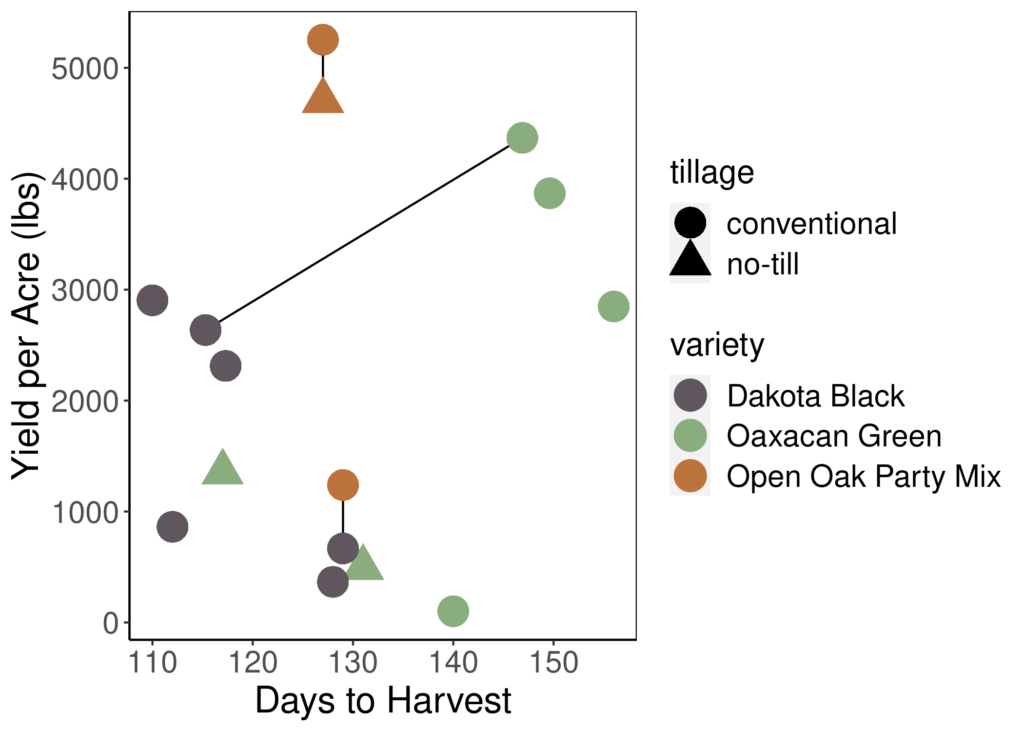
Sand content in soil may limit dry farmed corn success
We tested different soil chemical and physical parameters against out dataset to determine which may explain dry farmed yield differences between sites. Of the parameters tested, percent sand appeared to have a notable negative correlation with dry farmed yield (p = 0.005; Figure 5). Conversely, a higher silt and clay content was associated with greater dry farmed yields (not shown). This observation is predictable, as sandier soils hold onto less water, making it less available to roots in the soil profile. Based upon this simplified linear model on our dataset, we estimate that per 10% increase in soil sand content, there was a dry farmed corn yield reduction of approximately 920 lbs per acre.. However, a more systematic study would need to be done to confirm the accuracy of this estimate. Furthermore, certain hydrological properties of the soil such as having a high water table would reduce negative effects of sand content.

Dry Farmed versus irrigated comparisons in yield and economic factors
On three sites, producer cooperators compared irrigated plots of corn with adjacent dry farmed plots. Depending on site and variety, dry farmed corn plots yielded from 25% to 87% of irrigated corn plots (Figure 6). The site with the lowest relative dry farmed yield (25%; Site 2 on Figure 6) was our southernmost site, near Myrtle Creek, OR, which experienced the highest average temperatures throughout the season. Furthermore, it was one of the sandier sites, at 43% sand content, which suggests the soil had lower water holding capacity, and may not be as conducive to dry farming success. The producer at this site indicated that they would not be interested in dry farming corn at their farm again, though the provided soil moisture meters helped them make more informed decisions about the amount of irrigation water that was necessary to apply.
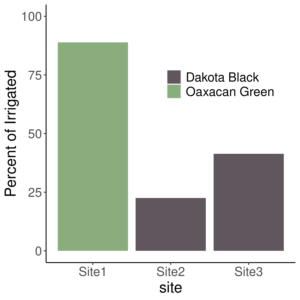
Despite potential yield losses due to dry farming, eight of the eleven producer cooperators indicated they are interested in dry farming corn in future years. Part of this is due to the economic costs associated with irrigation, including irrigation hardware, and hours spent maintaining and managing irrigation. One grower near Sweet Home, OR (Site 1 in Figure 6) drip-irrigated their corn for 30 total hours over the course of the season, and only experienced a 12% yield increase in Oaxacan Green dent corn, compared to their dry farmed corn plot.
Dry farming can also significantly reduce labor costs of weeding. Producers indicated they spent an average of 50% less time weeding their dry farmed plots than a typical irrigated plot, and one farmer wrote that they spent zero hours weeding their no-till dry farmed corn plot. This reduction in material and labor costs of dry farming may offset potential yield losses in some cases.
No-till methods in dry farmed corn production
In five sites, site operators explored no-till dry farming practices for corn production, three of which are presented in figures 4 and 5. On one of these sites, the OSU Oak Creek Center for Urban Horticulture, we directly compared dry farmed corn performance in new no-till plots versus adjacent tilled plots. On this site, Open Oak Party Mix dent corn in the no-till plot yielded 90% of the yield of conventionally tilled plot. We found no notable differences in tilled vs. no-till soil moisture profiles (not shown). As it can take multiple years to appreciate the benefits of no-till systems, we would assume this yield gap may narrow after more years of no-till management. Two producer collaborators near Portland, OR have been exclusively using no-till practices for diverse vegetable production for multiple years. Both farmers have found that dry farming fits well into their no-till systems, claiming that no-till methods tend to maintain higher soil moisture, increasing dry farming success. Finally, two of the no-till sites in this study experienced crop failures, and in both cases they were operators who had not used the method previously, at locations that were not previously under no-till cultivation.
Soil moisture monitoring
Seven producer participants successfully measured soil moisture tension at 1', 2', and 3' depth weekly over the course of the season, for a total of ten sites represented. Soil moisture tension, in centibars, represents the amount of force required to remove water from soil particles; the greater the moisture tension, the drier the soil is. Sandier soils inherently have a lower soil moisture tension as depicted in Figure 7, which makes between-site comparison more difficult. For each site, we were able to visualize when corn plant roots had entered a particular depth, as the soil moisture tension at that depth rapidly increased. At most of the sites, corn roots appear to have rooted to 2 ft. in depth by August 1st. At only 2 of the ten sites, corn roots did not appear to penetrate down to 3 ft. depth before harvest. The near-horizontal line on these graphs represents a site near Chimacum, WA that experienced a crop failure, so moisture tension did not significantly change throughout the season, indicating their soil's inherent ability to hold onto moisture throughout the arid summer months.

Survey
Seven project participants responded to our end-of-the-season survey. All seven respondents indicated they learned more about the potential of dry farming corn on their site, and all seven indicated they would like to dry farm corn again. Five of the seven survey participants indicated this project motivated them to increase the amount of dry farming on their site. All participants surveyed appreciated being able to monitor soil moisture throughout the year.
Breeding evaluations of Oaxacan Green dent corn and Dakota Black popcorn
Oregon State University site operators successfully evaluated 108 breeding lines of Oaxacan Green dent, and 124 breeding lines of Dakota Black popcorn for dry farming performance. Within each variety, we observed a significant negative correlation (p < 0.001) between days to silk emergence (a proxy for maturation timing) and dry farmed yield (Figure 8). With well-irrigated corn, this trend is typically the opposite, where later-maturing corn produces greater yield. However, dry farmed corn may benefit by maturing earlier, while there is more water available in the soil profile. Selecting a variety for early maturation may generally increase its potential for dry farming.
The top 20% of breeding lines of each variety were selected for dry farming performance, as well as ear and kernel quality. These top breeding lines are being planted in 2022 to generate an improved, open-pollinated population that is better suited for dry farming.
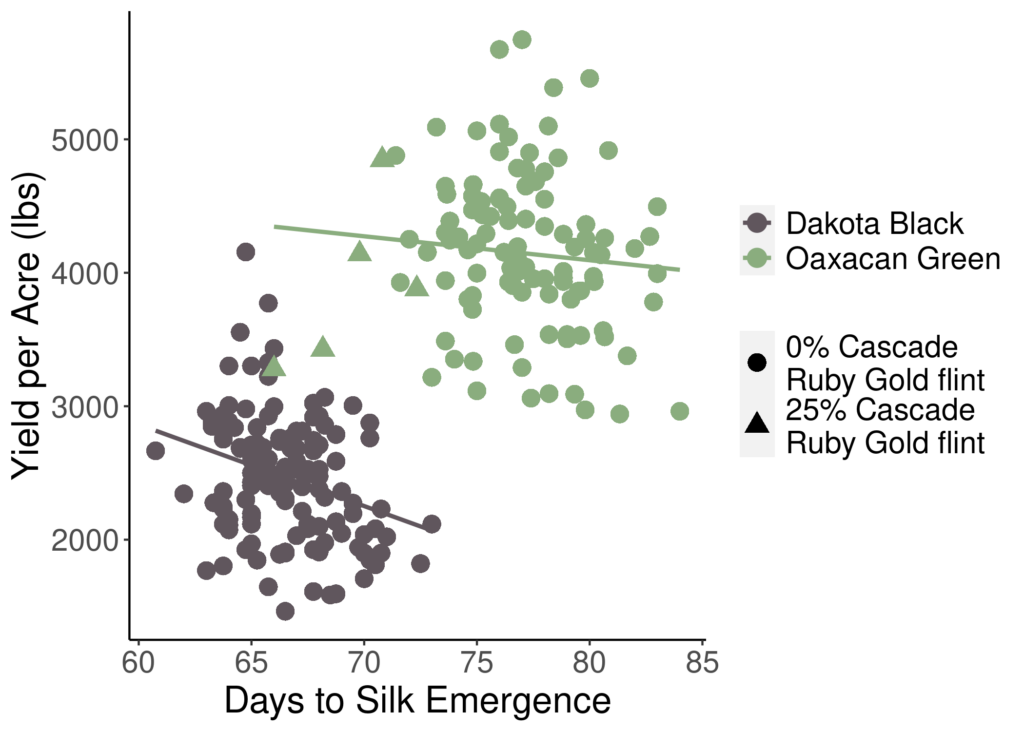
Marketing of dry farmed corn produce
The OSU operators are currently marketing dry farmed Dakota Black popcorn and Oaxacan Green dent corn produced from the breeding evaluation sites of this project, with collaborating vendors. The Dry Farming Institute 501(c)3 nonprofit is assisting with marketing of dry farming produce, with a "Dry Farmed" product logo. The dry farmed organic popcorn is being sold at a farm stand by a collaborator near Monroe, OR. We have provided dry-farmed, organic Oaxacan Green dent corn to Three Sisters Nixtamal, and are promoting tortillas made from their locally dry farmed Oaxacan Green masa through select vendors in Portland and Eugene, OR. We are expecting more growers to sell Oaxacan Green dent corn to Three Sisters Nixtamal in 2022.
Most growers produced only a small amount of corn through their trial sites in this project. However, a producer outside of Myrtle Creek will be selling his dry farmed popcorn as organic certified seed to Adaptive Seeds seed company near Brownsville, OR. Seed Companies have been expressing increasing interest in selling dry farming adapted crop varieties. Breeding material from the three corn varieties selected for dry farming performance in this project may end up in commercial seed catologs in the coming years.

Locally grown Oaxacan Green corn marketing campaign. Left: a flyer provided to Oaxacan Green corn tortilla vendors, with 'Dry Farmed' logo; center: Oaxacan Green corn masa produced by Three Sisters Nixtamal, Portland, OR; right: Three Sisters Nixtamal Oaxacan Green corn tortillas, for sale at a food co-op in Portland OR.
Research Outcomes
Education and Outreach
Participation Summary:
Oak Creek Virtual Field Tour, August 9th, 2021
On the Dry Farming Collaborative YouTube Channel, we featured our no-till vs. tilled comparison of Open Oak Party Mix dent corn, at OSU Oak Creek Center for Urban Horticulture (https://youtu.be/aCqRqJN2YIs)
Dry Farming Field Tour, August 26th, 2021
This project was a feature of the Dry Farming Collaborative in-person field day at the Oregon State University Vegetable Research Farm, that also included projects on dry farming soil management, bush dry beans, and tomatoes. At the field day, 60 participants were given a 20 minute presentation about the project, and an opportunity to observe and tour one of the replicate sites of Dakota Black popcorn breeding evaluations under dry farming conditions.
Dry Farming Collaborative Winter Convening, February 8th, 2022
The Dry Farming Collaborative Winter Convening, an annual event, is attended by farmers gardeners and practitioners from the Pacific Northwest, as well as other regions of the U.S., with other countries represented as well. During the 2022 meeting, which drew 92 participants, we outlined the main results of this 1-year research project in a 20-minute presentation. This meeting also enabled networking with new growers interested in becoming involved with participatory dry farmed corn research in future years.
Oregon Small Farms Conference Virtual Panel Discussion, February 19th, 2022
The dry farming adapted Open Oak Party Mix dent corn breeding portion of this project was featured in a panel discussion during the 2022 Oregon Small Farms Conference, entitled, “Stewarding Resilient Seeds for a Hotter, Drier Climate”, where PI Lucas Nebert was on the panel along with other seed stewards from Oregon, California, Colorado, and New Mexico, dedicated to preserving and breeding crops for drier climate. There were 96 attendees for this presentation.
Marketing of Oaxacan Green corn masa with Three Sisters Nixtamal, March 2022 - present
Three Sisters Nixtamal has been making masa from the organic Oaxacan Green corn produced as a result of breeding evaluations in this project. They are selling the green-colored masa and tortillas at the Portland State University farmers market, and a local food coop, both in Portland OR, as well as a vendor at the Lane County Farmers Market in Eugene, OR. We are providing consumers with informational flyers about this local corn product, including efforts to breed it for dry farming performance through this SARE funded project.
Education and Outreach Outcomes
Soil type appears to greatly affect dry farming success, yet even those farmers with sandier soils that hold less water are committed to continuing with dry farming as a climate adaptation tool. Many farmers report success with dry farming using no-till, and other soil-building practices. I would recommend future research on how much soil management practices such as no-till and mulching can remediate yield loss in sandier soils that inherently hold less water, when dry farming corn and other summer crops. There is a great interest among farmer participants in how sustainable soil management can improve dry farming outcomes.
